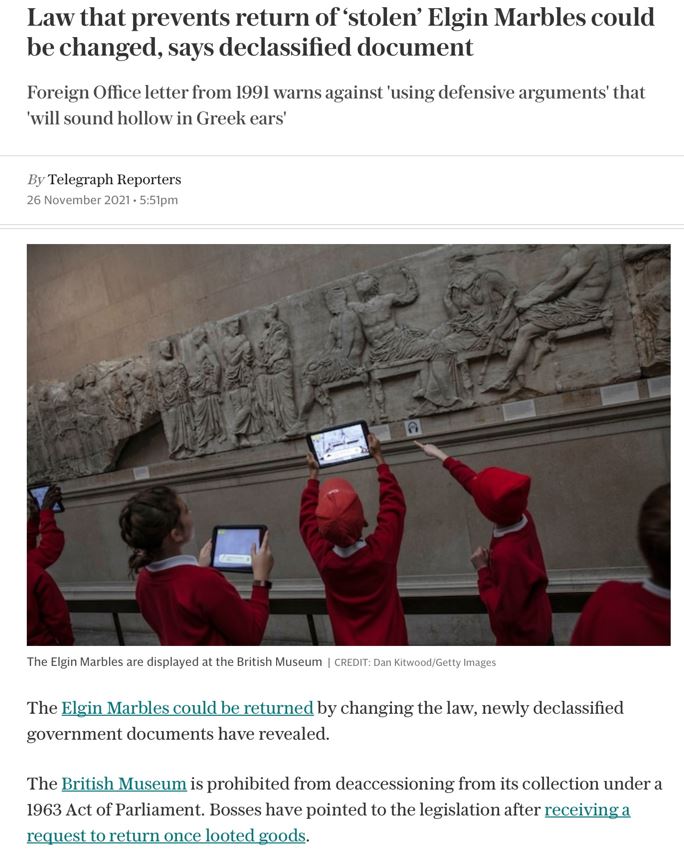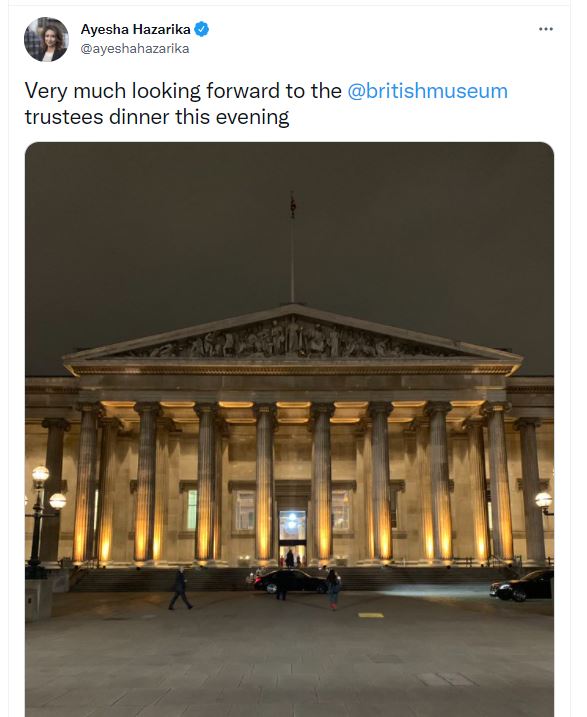TAN The Art Newspaper 23 November 2021
Martin Bailey reports on the classified documents on the sculptures from the Parthenon, compiled in 1991.
David Miers, became British Ambassador in Athens in 1989 and in 1991 organised a visit to Athens for the then Conservative arts minister Timothy Renton. After this visit, David Miers wrote a report for the Foreign Office which was passed on to the Office of Arts and Libraries (a precursor to the government’s culture department). In this report the UK Ambassador referred to the Parthenon Marbles as an "issue on which we can never win: the best we can do is to keep our heads down as far as possible: and avoid using defensive arguments here in Greece which will sound hollow in Greek ears.”
“For instance I do not think the argument about the trustees of the museum is a very good one for use here. The Greeks know that we could legislate [to allow deaccessioning] if we wanted: the problem for them is that we don’t want [to].”
A separate letter in the file argues that the Marbles would be safer in London than Athens. A foreign office official wrote that the British government cited “environmental concerns as further reasons for keeping the Marbles in their controlled environment in the British Museum”, in view of “severe air pollution in Athens”.
Then in 2009 the Acropolis Museum opened, and this year the British Museum has closed Room 18 for maintenance. Reports of the leaking glass roof began in December 2019 and in January and February 2020 heaters where placed in this room whilst in the summer months, the fire exit door was left open for ventilation, underlining the lack of climate controls. This year's closure of Room 18 continues.
During his meeting with Prime Minister Johnson, Greece's Prime Minister Kyriakos Mitsotakis pointed out that Greece still holds the UK government responsible for the continued presence of the Marbles in the British Museum.
To read the full article, please follow the link here.
Telegraph 26 November 2021

The Telegraph article cites The Art Newspaper article quoting the British Ambassador to Greece, Sir David Miers, admitting that the UK would not win the argument on the division of the Parthenon Marbles between Athens and London.
The Telegraph also picks up on a letter written by Johnson in 2012 when he was Mayor of London, where he admits that the sculptures from the Parthenon "should have never been removed from the Acropolis."
Saturday 27 November 2021, TA NEA
UK Correspondent Yannis Andritsopoulos interviews Denis MacShane and writes about the opportunity to reunite the sculptures when Tony Blair became Prime Minister.
Denis MacShane goes on to add that he'd met up with George Osborne at a recent function and the matter of the sculptures was raised, however George Osborne, just into his position as the new Chair of the British Museum, was 'full of contempt'.
George Osborne as part of the establishment will no doubt feel that he can be dismissive on this issue and follow the well rehearsed example of successive British Museum Directors and Chairs of the Trustees.
When Hartwig Fisher described the continued division of the Parrthenon Marbles as 'creative', the media world exploded, and when Prime Minister Boris Johnson met with Prime Minister Mitsotakis failing yet again to accept the UK governments responsibility, the media world found more letters and documents to prove that this dismissive attitude by the UK Government is not new. And yet times are changing. Where will the UK stand as more museums are doing their best to return artefacts removed from countries of origin where the voice of that nation, at that time, was not to be heard? History doesn't have to be rewritten for old wrongs to be put right, for there are cases when we can do better than just roll out contempt.
George Osborne made his first official speechduring a dinner held at the British Museum by the Trsutee on Wednesday 24 November. And in reading it, one can but conclude that there will be no visionary changes at the British Museum, with the exception of the new Museum in Nigeria to house the Benin Bronzes.This museum is designed by architect David Adjaye.
